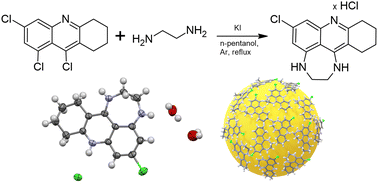A tetrahydroacridine derivative and its conjugate with gold nanoparticles: promising agents for the treatment of Alzheimer's disease†
Abstract
A new tetrahydroacridine derivative (CHDA) with acetylcholinesterase inhibitory properties was synthesized. Using a range of physicochemical techniques, it was shown that the compound strongly adsorbs onto the surface of planar macroscopic or nanoparticulate gold, forming a nearly full monolayer. The adsorbed CHDA molecules reveal well-defined electrochemical behavior, being irreversibly oxidized to electroactive species. The CHDA also exhibits strong fluorescence, which is effectively quenched after adsorption onto gold via a static quenching mechanism. Both CHDA and its conjugate reveal considerable inhibitory properties against acetylcholinesterase activity, which is promising from the perspective of therapeutic application in the treatment of Alzheimer's disease. Moreover, both agents appear to be non-toxic as demonstrated using in vitro studies. On the other hand, conjugation of CHDA with nanoradiogold particles (Au-198) offers new potential diagnostic perspectives in medical imaging.



 Please wait while we load your content...
Please wait while we load your content...